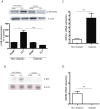Sepsis-induced acute lung injury (ALI) is milder in diabetic rats and correlates with impaired NFkB activation
- PMID: 23024779
- PMCID: PMC3443211
- DOI: 10.1371/journal.pone.0044987
Sepsis-induced acute lung injury (ALI) is milder in diabetic rats and correlates with impaired NFkB activation
Abstract
Acute lung injury (ALI) develops in response to a direct insult to the lung or secondarily to a systemic inflammatory response, such as sepsis. There is clinical evidence that the incidence and severity of ALI induced by direct insult are lower in diabetics. In the present study we investigated whether the same occurs in ALI secondarily to sepsis and the molecular mechanisms involved. Diabetes was induced in male Wistar rats by alloxan and sepsis by caecal ligation and puncture surgery (CLP). Six hours later, the lungs were examined for oedema and cell infiltration in bronchoalveolar lavage. Alveolar macrophages (AMs) were cultured in vitro for analysis of IκB and p65 subunit of NFκB phosphorylation and MyD88 and SOCS-1 mRNA. Diabetic rats were more susceptible to sepsis than non-diabetics. In non-diabetic rats, the lung presented oedema, leukocyte infiltration and increased COX2 expression. In diabetic rats these inflammatory events were significantly less intense. To understand why diabetic rats despite being more susceptible to sepsis develop milder ALI, we examined the NFκB activation in AMs of animals with sepsis. Whereas in non-diabetic rats the phosphorylation of IκB and p65 subunit occurred after 6 h of sepsis induction, this did not occur in diabetics. Moreover, in AMs from diabetic rats the expression of MyD88 mRNA was lower and that of SOCS-1 mRNA was increased compared with AMs from non-diabetic rats. These results show that ALI secondary to sepsis is milder in diabetic rats and this correlates with impaired activation of NFκB, increased SOCS-1 and decreased MyD88 mRNA.
Conflict of interest statement
Figures





References
-
- Alba-Loureiro TC, Munhoz CD, Martins JO, Cerchiaro GA, Scavone C, et al. (2007) Neutrophil function and metabolism in individuals with diabetes mellitus. Braz J Med Biol Res 40: 1037–1044. - PubMed
-
- Ferracini M, Martins JO, Campos MR, Anger DB, Jancar S (2010) Impaired phagocytosis by alveolar macrophages from diabetic rats is related to the deficient coupling of LTs to the Fc gamma R signaling cascade. Mol Immunol 47: 1974–1980. - PubMed
-
- Geerlings SE, Hoepelman AI (1999) Immune dysfunction in patients with diabetes mellitus (DM). FEMS Immunol Med Microbiol 26: 259–265. - PubMed
Publication types
MeSH terms
Substances
Grants and funding
LinkOut - more resources
Full Text Sources
Medical
Research Materials
Miscellaneous

